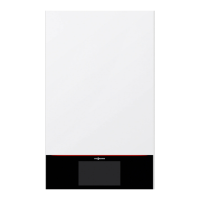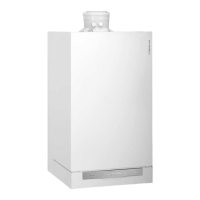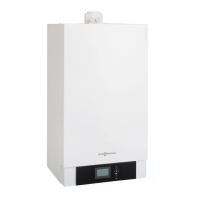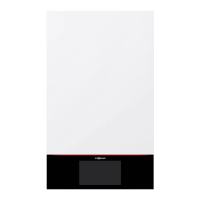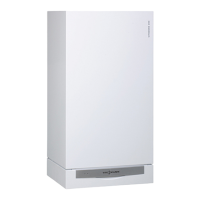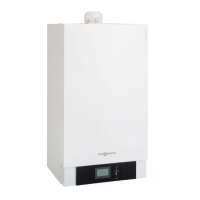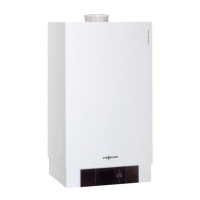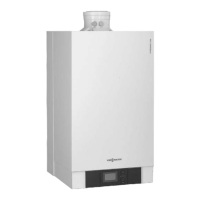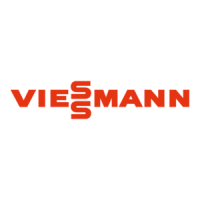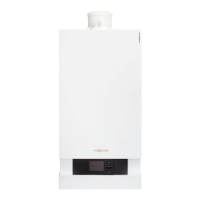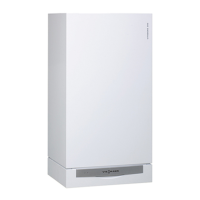What causes fault code 20 on a Viessmann Boiler?
- MMatthew ClarkAug 28, 2025
Fault code 20 on a Viessmann Boiler is caused by a short circuit in the system flow temperature sensor. You should check the low loss header sensor.
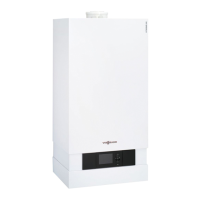










What causes fault code 20 on a Viessmann Boiler?
Fault code 20 on a Viessmann Boiler is caused by a short circuit in the system flow temperature sensor. You should check the low loss header sensor.
What should I check if my Viessmann Vitodens 200-W is showing fault code dC?
If your Viessmann Boiler is showing fault code dC, check the room temperature sensor for heating circuit 3. The fault code indicates a short circuit in that sensor (with mixer).
How do I troubleshoot fault code 30 on my Viessmann Vitodens 200-W?
Fault code 30 on your Viessmann Boiler indicates a short circuit in the boiler water temperature sensor. Check the boiler water temperature sensor.
What does fault code CE mean on a Viessmann Vitodens 200-W Boiler?
Fault code CE on a Viessmann Boiler indicates a communication error with the external extension. Check the connections and coding address "2E".
How to resolve fault code dE on a Viessmann Vitodens 200-W?
To resolve fault code dE on a Viessmann Boiler, check the room temperature sensor for heating circuit 2 and the remote control settings. This code indicates a lead break in that sensor (with mixer).
How to fix fault code bE on a Viessmann Vitodens 200-W?
To fix fault code bE on a Viessmann Boiler, check the connections, lead, coding address "A0", and remote control settings. This code indicates a communication error with the remote control Vitotrol for heating circuit 3 (with mixer).
What steps should I take for fault code C8 on my Viessmann Boiler?
For fault code C8 on your Viessmann Boiler, check the setting of coding address "E5". This code indicates a communication error with the external variable speed heating circuit pump for heating circuit 3 (with mixer).
How to acknowledge a fault on a Viessmann Vitodens 200-W?
To acknowledge a fault, follow the instructions on the display.
Why does the fault message reappear on my Viessmann Vitodens 200-W Boiler the day after I acknowledged it?
The fault message is re-displayed because the fault message facility has restarted.
Why does the fault display show 'E' on my Viessmann Boiler?
If the fault display on your Viessmann Boiler shows 'E', it indicates a fault in the burner control unit. You should check the burner control unit to resolve this issue.
| Type | Condensing Boiler |
|---|---|
| Installation | Wall-mounted |
| Heat Exchanger Material | Stainless steel |
| Efficiency | Up to 98% |
| Control | Vitotronic control |
| Fuel Type | Natural gas, LPG |
| Dimensions | 700 mm |
| Warranty | Up to 10 years |
| Output range | 1.8 to 35 kW (depending on model) |
General safety advice and precautions for users.
Explanation of warning symbols used throughout the manual.
Critical safety guidelines for installation and maintenance personnel.
User actions and restrictions regarding the appliance's operation.
Safety measures to follow during the normal operation of the system.
Conditions for safe installation and operation of the heating system.
Actions for gas leaks, fire, water leaks, and system faults.
Explanation of icons used throughout the manual for clarity.
Defines the appliance's purpose and operational limitations.
Details about the control unit and its various operating modes.
Information on initial system setup and configuration by a professional.
Details the default factory settings configured for the system.
Advice and recommendations for reducing energy consumption.
Recommendations for improving user comfort and system performance.
How the control unit and system functions operate.
Descriptions of different screen modes, indicators, and their meanings.
Explanation of the user interface controls and navigation.
How to set and manage the system's operating modes.
General overview and how to check system status and faults.
Adjusting room and domestic hot water (DHW) temperatures.
Switching between different system operating modes.
Accessing solar yield, WiFi status, and system pressure data.
Accessing advanced settings and time program configurations.
Step-by-step guide to setting time programs for heating and DHW.
Setting schedules for central heating circuits.
Managing time slots within existing time programs.
Setting schedules for domestic hot water (DHW) production.
Specific settings for DHW comfort and circulation pump operation.
Choosing heating circuits and setting desired temperature levels.
Enabling or disabling the central heating function.
Adjusting the heating curve for optimal efficiency and comfort.
Using functions like 'Extended heating' for short-term temperature changes.
Using the 'Day(s) at home' function for extended presence.
Utilizing the 'Holiday' program for energy savings.
Setting the desired temperature for domestic hot water (DHW).
Enabling or disabling domestic hot water production.
Manual DHW heating outside scheduled times.
Functions for hygiene, such as the 'Hygiene program'.
Setting to prevent scalding from hot water.
Adjusting screen brightness and the system indicator light.
Configuring the system's internal clock.
Customizing the display formats for time and date.
Settings for daylight saving, system language, and measurement units.
Setting up remote control and app connectivity.
Managing Wi-Fi and resetting the device to default settings.
Accessing help topics and checking system data.
Finding contractor details and checking energy consumption.
Configuring energy calculation factors and viewing software licenses.
Details on third-party software and service notifications.
Identifying and understanding system faults and error messages.
Procedure to reset the burner after an error occurs.
Confirming messages and reviewing the message history.
Activating and deactivating the emissions test mode.
Procedures for safely turning the system off.
Procedures for safely turning the system on.
Diagnosing and resolving issues related to cold rooms.
Resolving temperature and hot water problems.
Addressing particular display messages like 'Burner Fault'.
Procedures for cleaning and routine maintenance of the system.
Specific maintenance for appliance, cylinder, valve, and filter.
Handling damaged electrical connections and required replacements.
Explains the structure and navigation of the system menus.
Detailed breakdown of the main menu options and categories.
Specific menu categories for system control.
Specific menu categories for connectivity and energy tracking.
Specific menu categories for system information and device status.
Specific menu categories for heating circuits, DHW, and solar systems.
Specific menu categories for network, status, contractor, and system info.
Specific menu categories for system configuration and testing.
Definitions for system modes and version information.
Definitions related to operating programs, modes, and screed drying.
Explanations of different heating modes like WCO, CO, RTDO.
Definitions for heating modes and explanation of heating curves.
Definitions related to heating curves and heating circuits.
Definitions for system components and operations.
Definitions for safety, solar, water, and temperature-related components.
Definitions for operational modes and pumps.
Guidelines for disposing of the system and packaging responsibly.
